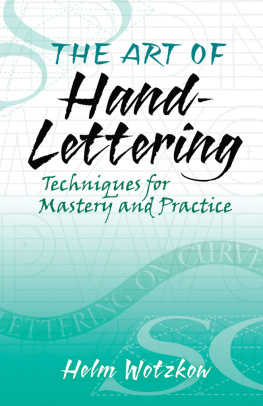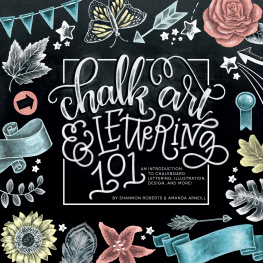THE ART OF
Hand-Lettering
Techniques for Mastery and Practice
Helm Wotzkow
Dover publications, Inc.
Mineola, New York
Copyright
Copyright 1952 by Watson-Guptill Publications, Inc.
All rights reserved.
Bibliographical Note
This Dover edition, first published in 2018, is an unabridged republication of the work originally published in 1952 by Watson-Guptill Publications, Inc., New York.
International Standard Book Number
ISBN-13: 978-0-486-82401-7
ISBN-10: 0-486-82401-2
Manufactured in the United States by LSC Communications
82401201 2018
www.doverpublications.com
to Erna,
for her loving patience
Publishers Note
FOR SOME TIME now we have been seeking a general text and reference book on lettering a book sufficiently broad and comprehensive to appeal, on the one hand, to those who wish to do creative lettering, and, on the other, to the buyers or users of hand-lettering, with their need to appreciate and evaluate the creations of others.
When Helm Wotzkows manuscript for The Art of Hand-lettering recently came along, we knew that our search was over. For here is a book admirably meeting our specifications. Not only is its author a highly skillful letterer and designer now Foreign Art Director of the Colgate-Palmolive-Peet Company but he is a natural-born teacher, the sort who delights in analyzing the needs of his prospective readers, and in catering to those needs. Through his many years of combined teaching and professional experience he has learned precisely what kinds of information and inspiration are most valuable to the student, the teacher, the professional letterer and the buyer of lettering. Also, he has developed rare skill in presenting this pertinent material in the most readily assimilated word and picture form.
His illustrations, while not flashy or dramatic, are superb, as a thumbing through of these pages will reveal. Note that these illustrations do not consist primarily of the copy plate type of alphabet, or of the miscellaneous lettering examples, which some lettering books feature almost in overabundance. Instead, while alphabets and examples are by no means neglected, each of his numerous and diversified illustrations has been drawn especially for this book, to serve some specific purpose which is brought out by the accompanying text.
This text, by the way, is exceptionally well-handled, leading the reader by easy degrees from the most elementary of matters such as the selection of the needed drawing materials to, and through, numerous professional considerations. In various instances the author dramatizes his arguments by comparing the appropriate with the inappropriate, the right with the wrong.
Especially commendable is his effort to aid his reader to become a good self-critic. Having thoroughly acquainted him with the Roman alphabet the basis of practically all good lettering he then leads him to all the other well-known lettering styles: Italic, Script, Block and the far-too-often-neglected Gothic. Also, through a simple Formula, he establishes a means of judging hand-lettering.
Useful, indeed, are his instructions on methods of assembling and adjusting different letters to form words, and different words to form complete units of lettering. Revealing, too, are his discussions of layout, of reproduction, of congruity of lettering style to purpose, and a hundred other things. The section of expertly set type faces will likewise prove most helpful.
In all of this there is no hint that skill in lettering can be acquired without persistent study and practice. On the contrary, just as the art of lettering is stressed throughout the book the need for holding ever to high esthetic standards so is the craft. One learns how to manipulate his pencil, pen and brush, how to overcome errors or defects, how to work white on black, how to letter in perspective and on curves.
But why go on stressing the obvious? The book is here for all to see. We present it with the belief that, as a basic work, it will serve many types of readers. As already hinted, for the student, the teacher, the letterer, the designer and the layout man those who do hand-lettering or teach it it can well prove practically indispensable. It will be invaluable, also, to buyers or users of lettering: the art directors and art editors, the advertising agencies and art studios, the advertising departments of companies both large and small also publishers, typesetters and printers. In fact, who in this entire field cannot profit through a broader knowledge of this great art-craft?
Contents
Acknowledgment
For the many hours they generously spent in making drawings, offering constructive criticism and encouraging me when I most needed it, my special gratitude to Rodulfo Garcia, Aino Murk and Alex. G. Highton.
And to those many good friends, both here and abroad, who went to so much trouble to get me the various specimens of handwriting, my sincere thanks. Im sorry I couldnt use them all; they are most interesting.
Introduction
THIS BOOK IS WRITTEN for those who wish to learn the art of hand-lettering. Hand-lettering is a fascinating art, and, while being a useful one, it can and will afford the artist a great deal of pleasure and satisfaction not only from the standpoint of technical skill but also from that of creative ability and inventiveness.
How to books have been written on practically every imaginable human activity under the sun, and I have read many of them. I have found, however, that a lot of these books, while telling you how to do certain things, more often than not omit to tell you why they should be done that way.
I readily admit that this telling you why is not always the easiest thing in the world, for the simple reason that the teacher-author generally knows so many things about his subject which have become second nature to him that he probably often unconsciously forgets to mention them to his invisible student-reader. On the other hand, the invisible student-reader is not in a position to suddenly ask a pertinent question which might prove inspirational to the teacher and, properly answered, save the student a great deal of disappointment and experimenting.
To learn how is certainly not always to learn why, but to know why is the surest way of learning how and finally knowing how.
If I had not felt a definite need for this book I obviously would not have undertaken to write it. There are a great many excellent works showing various examples of hand-lettering at their imaginable best. There are also many exceptionally useful books containing all kinds of complete alphabets, ancient and modern, utilitarian and decorative, as well as beautiful and otherwise. A number of these books are so good that I would be proud to have been their producer, but their usefulness is restricted almost entirely to those who already know how to do lettering. The first group mentioned consists mostly of inspirational books, good to have on ones bookshelf to get ideas from or for purely esthetic enjoyment. As a rule, however, it is left to the readers imagination how most of the masterpieces reproduced were done, as well as why they were done this way. The other group, which I admit can at times be of some help to the student, may on the other hand lead him to become nothing more than a copyist. Just picking out letters from an existing alphabet and rearranging them into words is about as artistic as playing dominoes. Many an alphabet, designed as such, and forming a complete picture in itself, may give a very pleasing impression; but those identical characters taken out individually and rearranged with spaces between words and lines can, and surprisingly often do, give most shockingly amateurish results. This does not mean to say that the characters or letters themselves are badly formed, but that as a rule the copyist has been unable to grasp fully the original designers intentions. I speak here of really well-designed alphabets and not of the hundreds of phantastically misshapen oddities which are periodically presented as modern alphabets.








